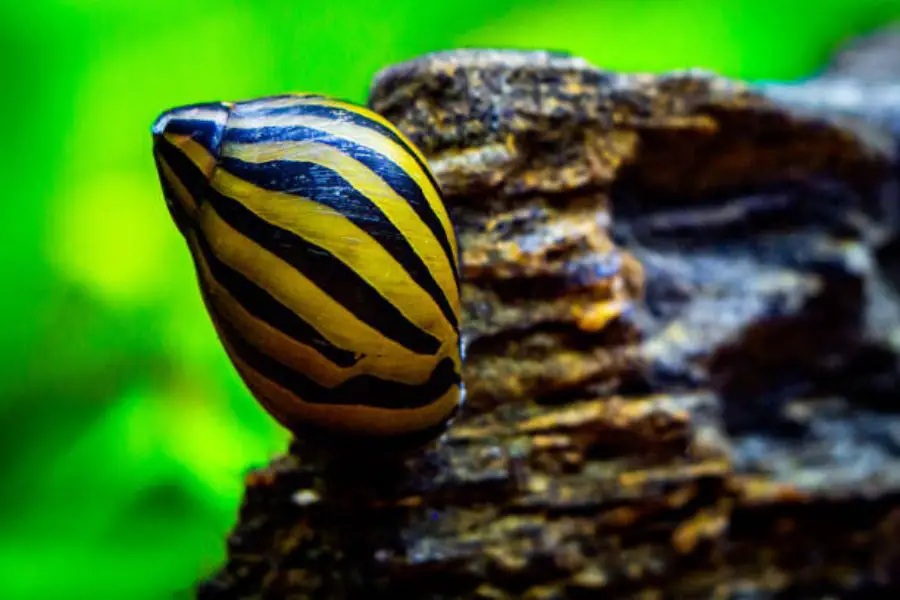Nerite snails are hugely popular for freshwater aquariums because they are voracious algae eaters, come in interesting patterns, and don’t reproduce in captivity.

But these benefits quickly sour when you find your nerite population mysteriously dwindling. Nothing is sadder than discovering their tiny corpses littering your tank. So Why Your Nerite Snails Keep Dying ?
Take heart – in many cases, a few adjustments can help your nerites thrive. Understanding the common pitfalls can help you provide the conditions these sensitive snails need to live their best life under your care.
Trouble Signs Your Nerites are Unhealthy
Jump To
Catching issues early makes revival attempts more successful. Watch for these red flags:
- Lethargy and reduced activity
- Retreating fully into their shells
- Loss of appetite and disinterest in food
- Climbing above the waterline (not just for a quick breath)
- Eroding or damaged shells
- White deposits or spots forming on shells
- Hanging limply from surfaces vs actively grazing
Any of these are cues something is amiss and intervention is needed before it’s too late.
Why Your Nerites Keep Perishing
Once you spot any of those unhealthy behaviors, take action to remedy the possible culprits:
Incorrect Water Parameters
Nerites need pristine water to thrive. Ammonia and nitrite spikes from overfeeding or overstocking burn their sensitive skin. Low oxygen, improper pH, heavy metals, and other toxins also take a toll. Test and correct your water quality.
Salinity Fluctuations
Nerites require constant, stable freshwater conditions. Even small amounts of salt can be deadly. Avoid marine saltcreep or mixing nerites in brackish tanks.
Lack of Calcium
Insufficient calcium, or low pH making calcium unavailable, leads to eroding shells. Supplement their diet and use aragonite substrate.
Physical Aggression
Boisterous tankmates that ram nerites can crack their shells. Avoid housing them with rambunctious fish like cichlids.
Starvation
Though nerites graze on algae naturally, supplements are also needed in aquariums. Especially avoid calcium deficiencies.
Dramatic Water Changes
Nerites dislike sudden shifts in water conditions. Acclimate them slowly and avoid overcleaning tanks.
Unsuitable Environment
Ensure their tank homes have ample grazing surfaces, hiding spots, clean water, and soft acidic substrate. An unstable habitat stresses nerites.
Caring for Nerites the Right Way
While they have a reputation as hardy algae eaters, nerites actually require close attention to thrive in aquarium environments. Here are top tips for success:
- Gradually acclimate snails to any new tanks to prevent shock. Temperature and pH shifts should be incremental.
- Test water parameters frequently and perform partial water changes to prevent ammonia/nitrite spikes. Provide good filtration.
- Use a soft, gravel or sand substrate. Larger grains avoid trapping active snails.
- Supplement with calcium-rich foods like blanched veggies and quality algae wafers or pellets.
- include driftwood, smooth rocks and ample plant growth to graze on.
- Ensure stable water conditions close to pH 7.5, medium hardness, and temperatures above 70°F.
- Change water gently to avoid dislodging snails. Limit water replacements to 25% weekly.
- Use air stones or surface agitation to maintain oxygen saturation.
- Only house with peaceful community fish that won’t pester snails.
- Check tank carefully before adding medications that could harm invertebrates.
Be Diligent for Snail Health
While nerites are not high-maintenance pets, ignoring their environmental needs is a recipe for disaster. Their sensitivity means vigilance is required to notice issues before it’s too late.
But don’t let difficulty dissuade you – healthy nerites are well worth the effort for their charming behaviors and relentless algae cleaning! Stay attentive to their needs and your nerite snails can thrive for years, hoovering up that unsightly green algae.
FAQs About Caring for Nerite Snails
How long do nerite snails live?
1-3 years is average, but they can exceed 5 years in optimized aquarium conditions.
Do nerite snails reproduce in freshwater?
No, their larvae require brackish or saltwater to survive. The white eggs you see won’t hatch but must be manually removed.
Can you keep nerite snails with betta fish?
Yes, nerites work well with bettas as long as the betta doesn’t exhibit aggressive nipping behaviors that could damage snail antennae.
Do nerite snails eat fish poop?
In addition to algae, nerites will scavenge waste including fish poop and uneaten food debris. Their activity helps keep tanks clean.
Why are my nerite snails not moving?
Lack of movement or lethargy is a bad sign indicating stress or illness. Test water parameters and make any necessary corrections immediately.
How often should you feed nerite snails?
2-3 times per week is sufficient along with their constant algae grazing. Avoid overfeeding that degrades water quality.
Be proactive and address any husbandry issues promptly to help your sensitive nerites continue powering through green algae. With attentive care, these hardworking snails can be fixtures cleansing and adding interest to freshwater tanks for years.
Read Next: My Journey with Saltwater Nerite Snails: A Comprehensive Guide to Care
